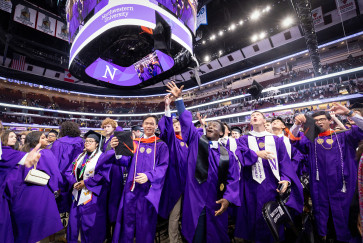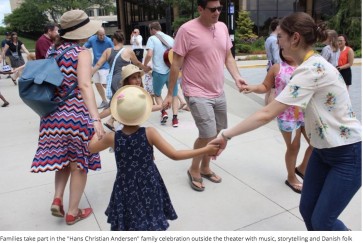“What is it?” That’s the question that led this week’s cover story in The Washington Post (Nov. 15).
That opening tease by the Post writer refers to “Prototype for Re-Entry,” the “seemingly lifelike” 36-foot-long fiberglass and steel sculpture created by Northwestern University’s Iñigo Manglano-Ovalle, an internationally known artist.
“Sleek yet weighty, covered in polished metal,” the sculpture hangs from the seven-story dome of the Food and Drug Administration’s (FDA) new building near Washington, D.C. -- “in the largest indoor atrium in federal government hands,” according to Post writer Marc Kaufman.
The sculpture by Manglano-Ovalle, professor and chair of the department of art theory and practice at Northwestern, could be “an abstracted sea creature starting a dive,” said Kaufman in the Post piece. “Seen sideways from a few stories up, it brings to mind a huge plunging bird, wings tucked in and about to hit the water.”
The campus’ four other ambitious sculpture installations all relate closely to the FDA’s mission of assessing new drug devices, vaccine and biologics. But Manglano-Ovalle’s sculpture relates more to the history of the FDA campus. For Manglano-Ovalle, “How Nazi scientists and their wind tunnels ended up in D.C. suburbs,” the title of the Post piece, “is just the starting point. The art project probed the legacy of the site and with it our own role in the proliferation of arms. Beginning with the Cold War and up to its current use to test military as well as civilian designs, including re-entry vehicles for the latest Mar’s lander.”
The sculpture artistically “harks back to the day in 1912 when three prominent sculptors and painters, including Constantin Brancusi, visited the Paris Air Show and saw propellers and other soon-to-be military objects that the three concluded were more artistically important than anything they had created,” Kaufman wrote.
Manglano-Ovalle proposed inserting a full-scale (54 inches) replica of Brancusi’s 1925 sculpture “Bird in Space” into Tunnel #9 in order to test it at hypervelocity re-entry speeds. NASA was enlisted to run a virtual test of the sculpture and to determine the speed at which it would re-enter the Earth’s atmosphere. NASA calculated that Brancusi’s sculpture would reach MACH 10, and as a result, the same velocity was used to test Manglano-Ovalle’s replica in the Air Force’s hypervelocity tunnel.
The Northwestern artist “set out to lure viewers into a challenging world -- to first attract them by the appealing look of the sculpture, then invite them to wrestle with the troubling tale about all that surrounds it.”
“Prototype for Re-Entry” sheds light on the history of the original wind tunnel complex by an artist “who is drawn to ‘where the beautiful meets the monstrous,’” Kaufman wrote.
During World War II, Tunnel #1 -- one of a series of pioneering hypervelocity wind tunnels developed by the Nazi-era Germans at a weapons center on the Baltic Sea and later moved to Bavaria -- was used to test rocket weaponry, including their infamous V-2 rocket design -- the world’s first guided ballistic missile. More information available online.
In the late 1940s, two of these German-designed wind tunnels were re-built at the White Oak Naval Ordnance Laboratory in Silver Spring, Md., and a dozen of the German scientists re-relocated to the Washington, D.C., area to continue their work on missile weaponry for the U.S.
Manglano-Ovalle’s project at Arnold Engineering Development Complex (AEDC), the most advanced and largest complex of flight simulation test facilities in the world, used the Air Force’s hypervelocity Tunnel #9, which was developed by the U.S. to test ballistic missiles at 10 to 12 times the speed of sound.
As a result of the three-year project, the artist then fabricated a 36-foot fiberglass and steel version of “Bird in Space.” This larger-than-life sculpture titled “Point of Re-Entry” was commissioned by the General Services Administration (GSA) Art in Architecture program and now hangs inverted in the FDA headquarters.
“Yes, it’s very important that what happened at wind tunnel Number 1 not be forgotten because it came here shrouded in moral ambiguity,” Manglano-Ovalle said in the article. “It’s an important part of our own history.”
It is “a past that includes captured German equipment and scientists from the Nazi era; the development of weaponry from nuclear warheads to intercontinental ballistic missiles…” and much more.
Besides Manglano-Ovalle’s responsibilities as chair of the department of art, theory and practice, he advises graduate students on their MFA theses and coordinates the Thesis Exhibition with Northwestern’s Mary and Leigh Block Museum of Art. He has taught undergraduate seminar and studio courses on varying subjects, including sculpture and installation practices. His favorite class is “Alternatives to the Object.”
Northwestern’s department of art theory and practice explores both the making of contemporary art and the ideas and theories that drive it. The department fosters intellectual independence, critical dialogue and practices that push the boundaries of aesthetic and cultural experience and includes widely-exhibited and acclaimed artists that represent diverse artistic concerns, practices and media.
The department’s 11-member faculty is comprised of widely-exhibited and acclaimed artists that represent diverse artistic concerns, practices and media, giving students access to a variety of viewpoints.

